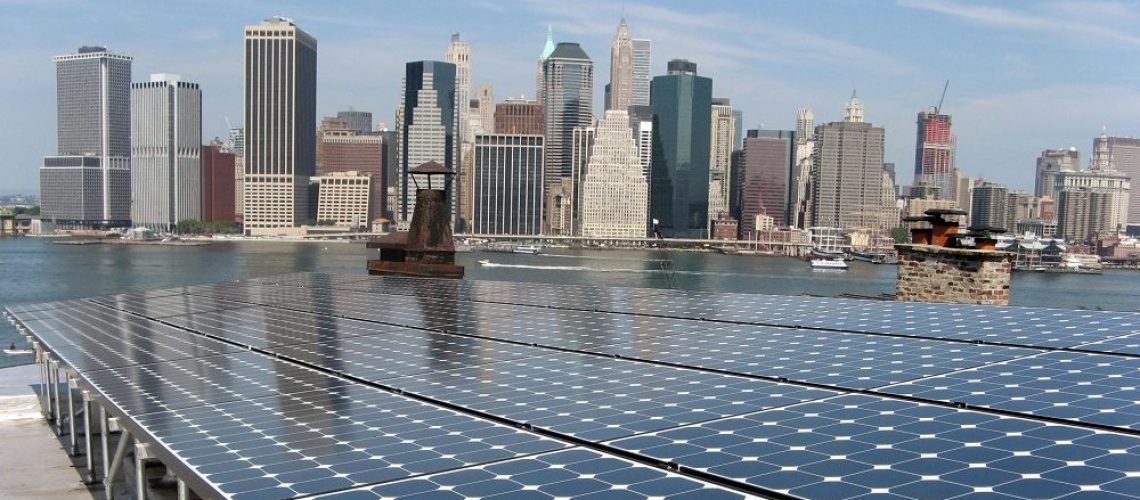The bill would authorize the New York Power Authority to build, own, and operate renewable energy projects to provide renewable energy to all state-owned properties by 2030 and municipal-owned properties by 2035, while also calling on the authority to phase out its fossil fuel power plants by 2030 and provide and deliver only renewable energy to customers.
June 3, 2022
With the end of the New York State legislative session rapidly approaching, climate and renewable energy advocates are hoping to see continued action on the New York State Build Public Renewables Act (S6453C), which recently passed in the state senate.
The New York State Build Public Renewables Act would authorize the New York Power Authority (NYPA) to develop and implement renewable energy projects that will ensure New York State can meet the goals laid out in the 2019 Climate Leadership and Community Protection Act (CLCPA), achieving 70% of the state’s electricity from renewable sources by 2030 and the governor’s goal to achieve 10 GW of solar by 2030.
The Build Public Renewables Act would:
- Authorize the New York Power Authority to build, own, and operate renewable energy projects.
- Require the New York Power Authority to phase out its fossil fuel power plants by 2030 and provide and deliver only renewable energy to customers.
- Require the New York Power Authority to be the sole provider of renewable energy to all state-owned properties by 2030 and municipal-owned properties by 2035.
- Authorize the New York Power Authority to offer renewable energy to residential customers, with a requirement to offer low-to-moderate income customers an energy supply rate that is 50% lower than the rate of the customer’s local utility.
- Require New York Power Authority projects and programs to pay a prevailing wage and utilize project labor agreements.
While we don’t yet know the scope of renewables that would be installed if this bill were to pass, it would likely be significant capacity, as NYPA would be looking to replace the 461 MW of natural gas fired peaker plants that it operates across New York City and Long Island.
The bill also has a carveout for equitable access to the proposed clean generation capacity additions. It would authorize NYPA to sell renewable energy to residential end-use customers and Community Choice Aggregation communities, but any excess renewable energy not used for state or municipal buildings is to be directed to low-to-moderate (LMI) income customers first, at a rate that is fifty percent less than the energy supply rate of the local utility in the customer’s service territory. The bill also asserts that LMI customers in disadvantaged communities are to be prioritized.
“As the largest public owned utility in the country, the New York Power Authority has led the way in providing affordable energy in New York State,” said Senator Kevin Parker, bill sponsor and chair of the Committee on Energy and Telecommunications. “It is imperative that we convert our electrical grid to renewable energy to meet our climate goals in New York State, and this bill will enable NYPA to fully power State and municipal properties with renewable energy by 2030 and 2035 respectively.”
Renewable acceleration
The beginning of June has been a busy legislative and renewables period for the state of New York. On June 2, the New York Energy Research & Development Authority shared it is seeking feedback on the processes involved in auctioning projects for its soon-to-launch Build-Ready program. The purpose of the Built-Ready program is to derisk solar development at sites that the State of New York deems highly desirable for deploying solar power.
First, NYSERDA has a rolling Site Recommendation Form in place, with the team ‘prioritizing the development of existing or abandoned commercial sites, brownfields, landfills, former industrial sites, and other abandoned or underutilized sites.’ Once a site is submitted, NYSERDA will do a remote screening of the site to determine the highest layers of viability, with further assessments and designs to determine financial viability, as well as other pre-screening techniques to follow.
After those steps have been completed, the state will take on the financial and time risks of getting landowners to agree to host a solar power project, gaining zoning approval from the local jurisdictions, and working through interconnection with the local utility or the New York ISO.
Also on June 2, New York Governor Kathy Hochul announced awards for 22 large-scale solar and energy storage projects to be constructed across the state, which together will add more than 2 GW of clean energy and roughly 160 MW (likely 640 MWh) of storage added to the grid. These projects are also being procured in pursuit of achieving 70% of the state’s electricity from renewable sources by 2030 and the governor’s goal to achieve 10 GW of solar by 2030. Once on-line, they are anticipated to raise the state’s renewable supply of its energy mix to around 66%.
In developing the 22 listed projects, developers have committed nearly $86 million in investments in disadvantaged communities throughout the state, including community-based investments such as new occupational apprenticeships, scholarship programs, and summer camps focused on supporting local disadvantaged communities. Additionally, all developers have committed to ensuring that workers associated with the construction of projects are paid a prevailing wage, a standard set by the NYS Department of Labor.
The average statewide bill impact for the typical residential customer will be approximately $0.13 per month once the projects are in operation, with all 22 projects having a weighted-average all-in development cost of $63.08 per MWh.



